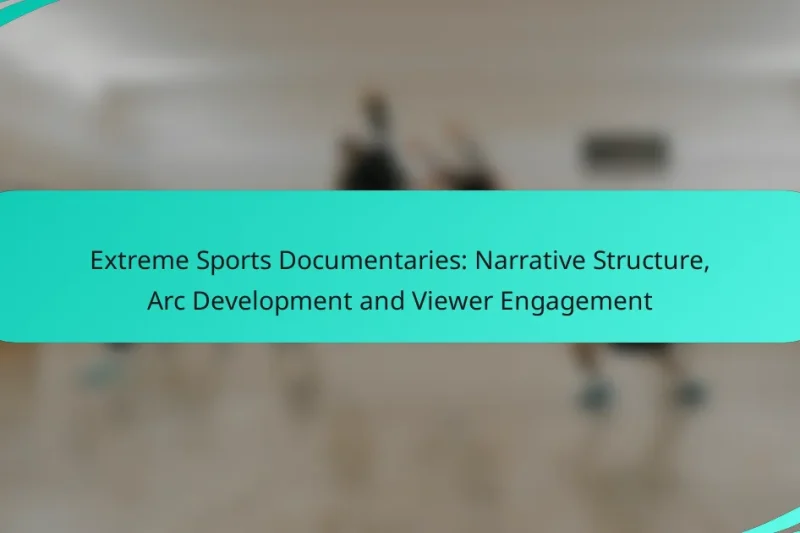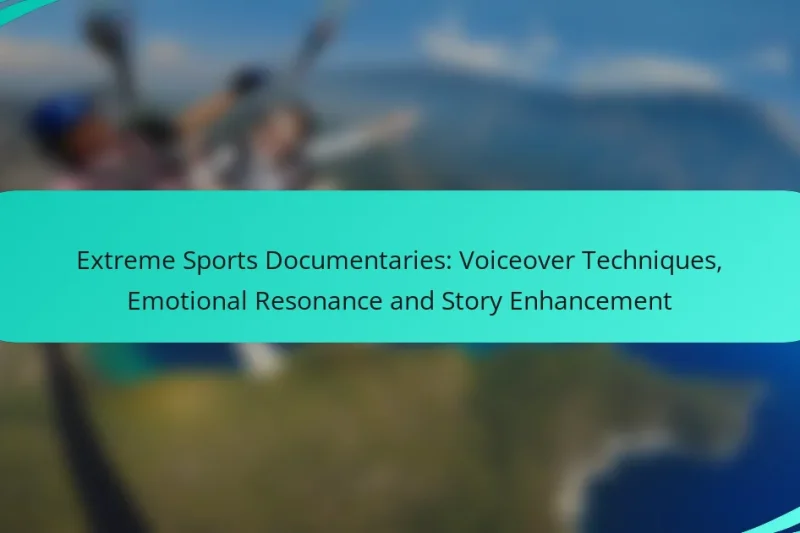Extreme sports documentaries uniquely captivate audiences by intertwining breathtaking visuals with powerful narratives and emotional depth. … Extreme Sports Documentaries: Narrative Structure, Arc Development and Viewer EngagementRead more
Extreme Sports Documentary Production: Storytelling in Extreme Sports
Extreme sports documentaries are crafted through authentic storytelling, stunning cinematography, and insightful athlete interviews, creating narratives that captivate viewers. By focusing on the thrill, challenges, and triumphs of athletes, these films highlight the essence of extreme sports while engaging audiences through character development and visual aesthetics. Selecting the right distribution platform is crucial, as it influences audience reach and the overall impact of the documentary.
Extreme Sports Storytelling: Cultural Context, Authenticity and Audience Connection
Extreme sports storytelling serves as a powerful medium that reflects the cultural values and beliefs of … Extreme Sports Storytelling: Cultural Context, Authenticity and Audience ConnectionRead more
Extreme Sports Documentaries: Voiceover Techniques, Emotional Resonance and Story Enhancement
Extreme sports documentaries leverage voiceover techniques to enrich storytelling, providing essential context and emotional depth that … Extreme Sports Documentaries: Voiceover Techniques, Emotional Resonance and Story EnhancementRead more
How to produce compelling extreme sports documentaries?
Producing compelling extreme sports documentaries involves a focus on authentic storytelling, high-quality cinematography, and engaging athlete interviews. These elements work together to create a captivating narrative that resonates with audiences.
Focus on authentic storytelling
Authentic storytelling is crucial in extreme sports documentaries as it connects viewers emotionally to the athletes and their experiences. Highlight personal journeys, challenges, and triumphs to create a narrative that feels genuine and relatable.
Consider using a narrative arc that includes conflict, resolution, and character development. This approach helps to maintain viewer interest and provides a deeper understanding of the sport and its participants.
Utilize high-quality cinematography
High-quality cinematography is essential for capturing the adrenaline and beauty of extreme sports. Invest in professional equipment and skilled camera operators to ensure dynamic shots that showcase the action effectively.
Consider using various filming techniques, such as aerial drones for breathtaking landscape shots or slow-motion for dramatic moments. These techniques can enhance the visual storytelling and immerse viewers in the experience.
Incorporate athlete interviews
Athlete interviews add depth and personal insight to extreme sports documentaries. Conduct interviews that explore the athletes’ motivations, fears, and experiences to create a more intimate connection with the audience.
Use a mix of on-camera interviews and candid moments to capture authentic reactions. This approach helps to humanize the athletes and allows viewers to relate to their stories on a personal level.
Highlight unique locations
Unique locations play a significant role in extreme sports documentaries, as they often serve as the backdrop for thrilling action. Showcase the distinct features of each location, whether it’s a breathtaking mountain range or a challenging urban environment.
Consider the cultural and environmental aspects of these locations, as they can add richness to the narrative. Highlighting local traditions or challenges can provide context and enhance the overall storytelling experience.
What are the key elements of extreme sports storytelling?
Extreme sports storytelling revolves around engaging narratives that highlight the thrill, challenges, and triumphs of athletes. Key elements include character development, conflict and resolution, and visual aesthetics, all of which contribute to a compelling viewing experience.
Character development
Character development is crucial in extreme sports documentaries as it allows viewers to connect emotionally with athletes. This involves showcasing their backgrounds, motivations, and personal journeys, which can include struggles, achievements, and their passion for the sport.
For instance, a documentary might follow a young skateboarder from a small town, detailing their rise to prominence and the obstacles they face along the way. Highlighting their personality traits, such as resilience and determination, can make the story more relatable and inspiring.
Conflict and resolution
Conflict and resolution are central to storytelling, providing tension and a narrative arc. In extreme sports, conflicts often arise from physical challenges, personal fears, or external pressures, such as competition or injury.
Documentaries can illustrate these conflicts by capturing moments of failure or near misses, followed by the athlete’s journey to overcome these hurdles. For example, a climber might struggle with a difficult route but ultimately find a way to succeed, showcasing their growth and tenacity.
Visual aesthetics
Visual aesthetics play a significant role in extreme sports storytelling, as stunning visuals can enhance the narrative and draw viewers in. High-quality cinematography, dynamic camera angles, and slow-motion shots can capture the adrenaline and beauty of extreme sports.
Using techniques like drone footage or underwater cameras can provide unique perspectives that elevate the storytelling. Additionally, incorporating the natural environment—such as mountains, oceans, or urban landscapes—can create a vivid backdrop that complements the athletes’ journeys and challenges.
Which platforms are best for extreme sports documentaries?
For extreme sports documentaries, platforms like YouTube, Vimeo, and Netflix each offer unique advantages that cater to different audiences and content styles. Choosing the right platform depends on your target audience, desired quality, and distribution goals.
YouTube for broad reach
YouTube is ideal for filmmakers seeking to maximize exposure and reach a wide audience. With billions of users, it allows for easy sharing and engagement through comments and likes, making it a great platform for community building.
To succeed on YouTube, focus on creating engaging thumbnails and titles, as these attract viewers. Regular uploads and interaction with your audience can also help grow your channel and increase visibility.
Vimeo for high-quality content
Vimeo is known for its emphasis on high-quality video and artistic content, making it suitable for extreme sports documentaries that prioritize visuals and storytelling. The platform offers tools for creators to showcase their work in a professional manner.
Consider using Vimeo’s customizable player and privacy settings to control how your content is shared. This can be particularly useful for filmmakers looking to present their work in festivals or private screenings.
Netflix for niche audiences
Netflix caters to niche audiences and can provide a significant platform for extreme sports documentaries that tell compelling stories. Securing a spot on Netflix can lead to increased visibility and potential revenue through licensing deals.
To get your documentary on Netflix, focus on producing high-quality content that aligns with their programming needs. Networking with industry professionals and attending film festivals can also help you gain access to decision-makers at streaming platforms.
What are the challenges in extreme sports documentary production?
Extreme sports documentary production faces several challenges, including safety concerns, budget constraints, and logistical issues in remote locations. Each of these factors can significantly impact the quality and feasibility of the project.
Safety concerns during filming
Safety is paramount in extreme sports documentary production due to the inherent risks involved in activities like base jumping, rock climbing, or surfing. Filmmakers must ensure that all crew members are equipped with proper safety gear and training to handle emergencies.
Establishing safety protocols, such as having medical personnel on-site and conducting risk assessments, is crucial. Filmmakers should also consider the safety of athletes and the environment, ensuring that filming does not endanger anyone involved.
Budget constraints
Budget constraints can limit the scope and quality of extreme sports documentaries. High-quality equipment, safety measures, and skilled personnel often come with significant costs, which can strain available resources.
Filmmakers should prioritize spending on essential aspects like safety and equipment while seeking sponsorships or partnerships with brands in the extreme sports industry. This approach can help alleviate financial pressures and enhance production value.
Logistical issues in remote locations
Filming extreme sports often takes place in remote locations, presenting logistical challenges such as transportation, accommodation, and access to necessary resources. Planning is essential to ensure that all equipment and crew can reach these sites safely and efficiently.
Using local guides can facilitate navigation and provide insights into the best filming spots. Additionally, filmmakers should prepare for potential weather disruptions and have contingency plans in place to adapt to changing conditions.
How to market extreme sports documentaries effectively?
To market extreme sports documentaries effectively, focus on engaging your target audience through dynamic content and strategic outreach. Utilize various platforms and partnerships to maximize visibility and create a buzz around your film.
Leverage social media channels
Social media is crucial for promoting extreme sports documentaries. Platforms like Instagram, TikTok, and YouTube allow you to share captivating clips, behind-the-scenes footage, and engaging stories that resonate with adventure enthusiasts.
Consider creating a content calendar to maintain consistency in posting. Use hashtags relevant to extreme sports to reach a broader audience and engage with followers through comments and direct messages.
Collaborate with influencers
Partnering with influencers in the extreme sports niche can significantly enhance your documentary’s reach. Look for individuals who have a strong following and align with the themes of your film.
Influencers can help promote your documentary through reviews, shoutouts, or even participation in promotional events. Establish clear expectations and provide them with exclusive content to share with their audience.
Utilize SEO strategies
Implementing effective SEO strategies is essential for increasing the online visibility of your extreme sports documentary. Focus on keyword research to identify terms that potential viewers might use when searching for related content.
Optimize your website and video descriptions with these keywords, and consider creating blog posts that delve into topics related to your film. This can drive organic traffic and improve your search engine rankings.


